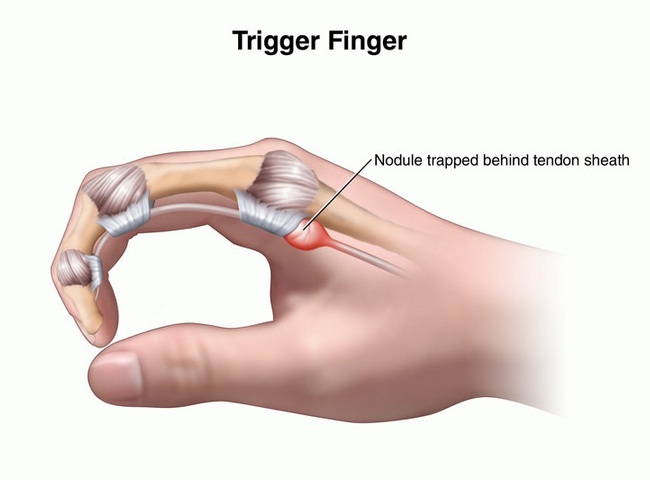 Trigger finger, also known as stenosing tenosynovitis, is a condition where one of the fingers gets stuck in a bent position. The finger can snap back in position with a trigger being pulled and released. The snap can get worse in the morning with mild pain and/or a small swelling at the base of the bent finger. The people who are at higher risk of developing trigger finger are the ones whose jobs or hobbies need repetitive gripping actions. It is also more commonly seen in women and diabetics.
Trigger finger, also known as stenosing tenosynovitis, is a condition where one of the fingers gets stuck in a bent position. The finger can snap back in position with a trigger being pulled and released. The snap can get worse in the morning with mild pain and/or a small swelling at the base of the bent finger. The people who are at higher risk of developing trigger finger are the ones whose jobs or hobbies need repetitive gripping actions. It is also more commonly seen in women and diabetics.
What Causes Trigger Finger?
The cause of trigger finger is not always very clear. It could be due to inflammation causing swelling of tendon or tendon sheath.
- The tendon which comes from the forearm passes through the palm and attaches to the finger bone. The muscle attached to the tendon pulls it which causes the finger to bend or flex the finger towards the palm
- The tendon sheath covers and protects parts of tendon like a tunnel. In normal cases, the tendon slides in and out of the sheath when the finger is bent or relaxed. When trigger finger occurs, the tendon slides out of the sheath when the finger is bent, but it cannot slide back due to swelling. Thus the finger remains bent unless straightened with other hand.
It is more commonly seen in females, especially over the age of 40. People whose work involves using the palm, like handling tools and screwdriver can suffer from trigger finger due to then inflammation in the palm. Trigger finger can also be seen in the people suffering from rheumatoid arthritis, amyloidosis, diabetes, carpal tunnel syndrome and people undergoing dialysis.
What Are the Symptoms of Trigger Finger?
Trigger finger symptoms are given below which can range from mild to severe:
- Stiffness in the fingers, especially in the mornings.
- A faint popping or clicking feeling when the finger is moved.
- At the base of the finger, the palm might be tender or have a bump or module.
- Finger remaining locked in the bent position which suddenly pops straight.
- Inability to straighten bent finger.
Trigger finger can affect the thumb, middle or ring finger more often, and more than one finger and both hands can be affected.
When to See a Doctor
If there is stiffness in the fingers or you experience catching in any finger joints, you should inform the doctor. A physical examination along with symptom review will be performed by the doctor. There are chances of infection if the finger joints are hot and inflamed.
How Is Trigger Finger Treated?
1. Medication
Medication is used to relieve the pain in the joints. NSAIDs like Ibuprofen are usually prescribed. However, they do not reduce the swelling in the tendon sheath.
2. Steroid Injection
As the most common form of treatment, it includes injecting a steroid containing medication near or into the tendon, which reduces the inflammation and allows free movement of the tendon. It is effective in 90% of the patients without diabetes. In diabetics, it is successful 50% of the time. A second shot of injection might be required for effective results.
3. Percutaneous Release
In this procedure, the doctor numbs the palm and inserts a needle in the tissue of the affected area. Under ultrasound, the needle is moved along with the finger so that the constriction is removed. Ultrasound helps in ensuring that the needle does not damage the tendon and nerves and opens only the tendon sheath.
4. Surgery
A small incision is made at the base of the affected finger and the constricted portion of the tendon sheath is surgically removed.
5. Noninvasive Treatments
- A splint. A splint is advised to be worn at night for up to 6 weeks, which keeps the tendon in an extended position and provides rest to the tendon. With the splint on, the fingers cannot be curled into a fist while sleeping, which otherwise makes it painful in the morning.
- Warm or cool. Some people find it helpful to use warm water soaks in the morning. While some people find improvement using ice packs on the palm, several times during the day
- Rest. Giving rest to the hand from activities which involve constant gripping, grasping or use of vibrating hand-held machinery for at least 3-4 weeks proves beneficial.
- Stretching exercise. The doctor can suggest exercises which will improve the mobility in the fingers.
How Long Does It Take to Recover From Trigger Finger?
The recovery time depends on the severity of the condition and also the type of treatment. If the finger is rested and anti-inflammatory drugs are taken, recovery can happen within few weeks. However, if splints are used, it usually takes 6 weeks to recover.
The video below introduce basic things you should know about trigger finger vividly:


